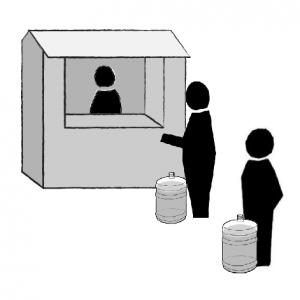يتواجد بائعي المياه بصورة شائعة في أجزاء متعددة من العالم حيث شح المياه أو نقص البنية التحتية يحُدّ من الوصول إلى مياه الشرب وذلك خاصةً في الأماكن الحضرية. المتاجرة في المياه (بيعها ) يشير لعدة أشكال لبيع المياه : وهى تتراوح مابين البائعين الذين يحملون المياه في حاويات ويدفعونها على عربات إلى أكشاك المياه حيث يقوم الأفراد بجلب المياه لأنفسهم . في الأدب (مجمل الأبحاث العلمية المنشورة يشير مصطلح "بيع المياه" إلى إعادة بيعها الرسمي وغير الرسمي أو توزيع الماء الصالح للاستهلاك , أو الماء من المصادر الأخرى من خلال صغار الباعة للاستخدام المنزليّ (على سبيل المثال: أكشاك المياه وناقلات المياه والأسر الذي تبيع المياه من خلال وصلات في منازلهم). لذا ستوضح هذه الورقة كيفية عمل أنظمة بيع المياه وتناقش آثارها على الصحة وفاعليتها في تغطية احتياجات الفقراء من الماء، أما بيع المياه المعبّأة سواءاً في زجاجات أو غيره فسيتم مناقشتها في ورقة أخرى.
بائعى المياه والأهداف الإنمائية للألفية
مقتبس من: KJELLEN & MCGRANAHAN (2006)
ووفقا للهدف الرسمي للأهداف الإنمائية للألفية، يتحقق تحسن عندما يتحول الناس من بائعي المياه أو المصادر غير المحسنة إلى وصلات أنابيب المياه أو أنابيب المواسير العامة الحرة على بعد كيلومتر واحد من منازلهم (انظر أيضا الوصول إلى المياه والمرافق الصحية). ولكن عن طريق قمع بيع المياه، هناك خطر من السلطات التي تجعل الحصول على المياه للسكان المحرومين أكثر صعوبة. إن الموقف السلبي تجاه بيع المياه يقلل من إمدادات المياه المتاحة ويضر بالمقيمين المحرومين من خلال زيادة الأسعار. إن قدرتها على الوصول إلى الفقراء وتحسين إمدادات المياه في المناطق التي يصعب تطويرها مع البنية التحتية التقليدية هي خدمات مهمة (كيلين & مغراناهان 2006).
ومن ناحية أخرى، فإن الافتراض بأن بيع المياه أمر مرغوب فيه في حد ذاته هو أيضا مشكلة. وبالنظر إلى ارتفاع أسعار بيع المياه من قبل البائعين، فإن العديد من الأسر المعيشية ذات الدخل المنخفض لا تستطيع شراء كميات كافية من المياه لتلبية احتياجاتها من النظافة الصحية (انظر أيضا الحق في المياه والصرف الصحي). ويتمثل التحدي في تحسين خدمات المياه والصرف الصحي الحالية غير الكافية ، من خلال أكثر الوسائل فعالية المتاحة، بما في ذلك بائعي المياه حيثما كان ذلك ملائما (كجيلن & مغراناهان 2006) (انظر أيضا نقطة استخدام الماء المعالج ، و المعالجات اللامركزية لمياه الشرب، منهج التمكين، خطط سلامة المياه، الربط بين ادارة المياه والزراعة، invalid link.
ولا يوجد أي تناقض في استراتيجية المياه التي تهدف إلى حصول البائعين علي المساعدة لتوفير ماء محسن (والصرف الصحي والنظافة الصحية) لفقراء الحضر على المدى القصير، وإخراج الباعة من العمل عن طريق توفير خدمات مرافق أفضل على المدى الطويل (KJELLEN & MCGRANAHAN 2006)). ومن الخيارات الواضحة لتوسيع نطاق تغطية المياه مواصلة استكشاف آليات التوزيع القائمة لإعادة بيع ماء توصيل المنازل (كينر وآخرون 2010) (انظر أيضا أدوات الاستكشاف).

اوعية بائعي المياه من مصدر للماء في منازلهم في اوغندا. المصدر: WATERAID (n.y.)
بيع المياه يوجد فى أماكن عديدة فى العالم حيث ندرة إمدادات المياه أو عدم وجود بنية تحتية كافية للحصول مياه صالحة للشرب، وعلى الرغم من أنّ ذلك أكثر شيوعا في البلدان النامية إلا أنها موجودةٌ أيضاً في البلاد المتقدمة(WHO 2011) . بائعو المياه الذين ليس لديهم مرافقُ بيعٍ (الباعة الجائلون) سوف يشار اليهم من الآن فصاعدا ببائعي المياه] يقومون بخدمة هامة عن طريق ملء الفجوة بين العرض والطلب. من الممكن أن تتفاوت جودة وكفاية الإمدادات. (WHO 2011; KJELLEN & MCGRANAHAN 2006).انظر ايضا الماء والصحة والصرف الصحي و الوصول للمياه والصرف الصحى .

بيع الماء غير الرسمي طريقٌ أساسيٌ للمناطق المحرومة (غير المخدومة). المصدر: الماء والصرف الصحي للجميع (n.y.)
مقتبس منKJELLEN & MCGRANAHAN (2006)
المتاجرة في المياه (بيعها) يشير لعدة أشكال لبيع المياه: بيع الماء وتوزيعه من خلال عبوات يتراوح ما بين إيصال الماء عبر صهاريج إلى حمل الأفراد للعبوات. ربما يتم الحصول على المياه من الصنابير البلدية أو الخاصة، منصات أو اكشاك البيع الثابتة، الحصول على المياه من الأنهار أو الآبار، أو عن طريق محطات البيع العامة من الباب للباب , وبيع المياه أما يكون مباشرة من البائع للمشتري أو عن طريق وسطاء مثل الشركات التي توزع المياه على المستهلكين . (ZAROFF & OKUN 1984). وهنالك ثلاثة أنواع لبائعي المياه قد تم تعريفهم وفقا ل WHITTINGTON et al. (1989):
باعة الجملة: وهم الذين يحصلون على المياه من المصدر ويبيعونها الي الباعة الموزوعون
التوزيع سواء عن طريق باعة أو ناقلات. ويقوموا أما بالحصول على المياه من المصدر أو من بائعو الجملة ويسلموها مباشرة للمستهلكين من الباب للباب , وحاملو المياه يكونوا رجالا يستخدمون أنواع معينة من المعدات تستطع حمل كميات ثقيلة من المياه . وهى تكون حاويات بلاستيكية أو معدنية ويتم وضعها أما على الدراجات أو العربات التي تجر باليد أوعربات تجرها حيوانات أو شاحنات ميكانيكية أو خزانات مياه بمقطورة أو انظر ايضا التوزيع بعربات تجر باليد, أو عن طريق الشاحنات الناقلة, ويكون موزعو المياه من ذوى الدخول المنخفضة غالبا ويوفروها لغيرهم من ذوى الدخول المنخفضة
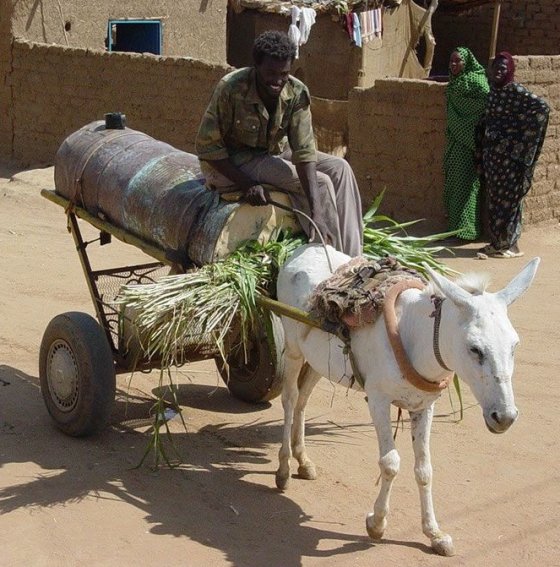
بائع وموزع للمياه في الخرطوم ,السودان المصدر: UN-HABITAT (2002)
هم الذين يقومون ببيع المياه مباشرة للمستهلكين الذين يصلون لمصدر مصدر المياه لشرائه على سبيل المثال : بيع المياه من خلال أكشاك المياه والصنابير والآبار والواصلات المنزلية , في المناطق التي يتم توصيل المياه عبر شبكات لبعض الأسر والبعض الأخر لا فتقوم تلك الأسر بالحصول على المياه من جيرانها , وفى العديد من المدن تدفع الأسر أسعار ثابتة لاستخدام المياه , لذا فأن أعادة بيع تلك المياه لأشخاص آخرون لا يؤثر على الفاتورة الشهرية لتلك الأسر لذا فتجارة المياه حينها تكون مربحة , أما البيع من خلال الصنابير وتعمل بشكل عقد ثابت على مكان بيع ثابت يتم فيه بيع المياه للمستهلكين ويحملون المياه معهم للمنازل التوزيع باليد البشرية
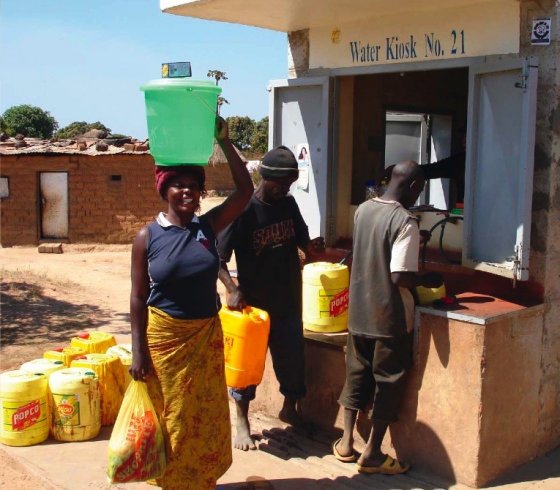
كشك للمياه في زامبيا المصدر: GTZ (2009)
يبدو أن النوع الأكثر شيوعا داخل القطاع الخاص المتعلق بخدمات المياه هو القطاع المتعلق ببائعي المياه سواء البائعين المباشرين أو متعهدي الماء والموزعون, ويصعب التحديد بدقة حصتهم من سوق المياه, ولكن الأبحاث الحديثة أثبتت بائعي المياه يوفرون خدمة هائلة للفقراء بخاصة لأن أغلب مناطق الفقراء لا يوجد بها بنية تحتية كافية لسد احتياجات مياه الشرب لهم(KJELLEN & MCGRANAHAN 2006) , وهناك قطاع ينمو بسرعة وهو قطاع المياه المعبأة مسبقا زجاجات المياه المعبأة .
يعمل بائعي المياه بجميع أنواعهم عادة في المناطق التي لا تكون شبكات( انابيب) المياه متوفرة أو سهل الوصول إليها ( انظر ايضا الفصل [ التوافر والتوزيع بالحصص] , وفى المناطق الحضرية الفقيرة لذا فهنالك تداخل جغرافي مابين فقراء الحضر وبيع المياه , حتى وان لم يكن هؤلاء الفقراء أهم العملاء (KJELLEN & MCGRANAHAN 2006), وفى الكثير من الأحيان يعملون بالمناطق الغير مطورة المتصلة بالمناطق الموجود بها مرافق (أنابيب) للمياه أو التي تدهورت فيها تلك المرافق , لذا فأنهم يؤدون خدمة موازية عن طريق ملء الفجوة بين العرض والطلب . إلا أن التوسع في مد خدمات انابيب المياه قد يؤدى إلى إفلاس بائعي المياه [ (KJELLEN & MCGRANAHAN 2006). في المناطق شبه الحضارية يقوم بائعي المياه بنقل المياه للأسر ذات الدخول المرتفعة والمتوسطة ويبيعون الماء من الباب الي الباب, إن لم يكونوا متصلين بخدمات المدينة ( موزوعون المياه ). , وتقوم الأسر ذات الدخل المنخفض فتقوم بجلب المياه من الجيران أو الصنابير المتصلة بمرافق (الأنابيب) المياه ( باعة مباشرون) . (KJELLEN & MCGRANAHAN 2006)
أن الموردين الرسميين وغير الرسميين على نطاق صغير قد يقوموا بالتعهد ببيع المياه , مصطلح "غير رسمي " يشير إلى جميع الموردين الذين لا يعملون تحت الإطار القانوني المختص بادارة المياه وتوزيعها في منطقة معينة (ANGUELTOU-MARTEAU 2008), انظر ايضا السياسات والاطار القانوني المسموح به ولكن بائعي المياه الرسميون هم ممارسون ذوي خبرة , المياه حينها تأتى من مصادر مياه معالجة او من مصادر مسجلة مضمونة ومصرح بها ويتم توفيرها أما عن طريق ناقلات لتلك المياه أو مباشرة للجمهور من خلال أكشاك لمياه أو أنابيب المياه المتصلة بمصدر المياه المعالجة , على عكس الموردين الغير الرسميين الذين يحصلون على المياه من مصادر مختلفة تشمل المياه غير المعالجة , ومصادر المياه السطحية و الآبار المحفورة باليد والابار ويسلمون كميات صغيرة من المياه للاستخدام المنزلي.انظر ايضا التوزيع باليد البشرية التوزيع الميكانيكى .
مقتبس من WHO (2011) and KJELLEN & MCGRANAHAN (2006)
وفيما يتعلق بنوعية المياه، غالبا ما يتم إلقاء اللوم على بائعي المياه في توفير المياه غير الآمنة (انظر أيضا invalid link ). ومن الصعب جدا تطبيق التنظيمات والوقاعد المنظمة والرصد، خاصة فيما يتعلق بالتعبئة اللامركزية وغير الرسمية (انظر أيضا تعزيز هيئات الإنفاذ الخاصة بمصادر المياهو إنشاء سياسات وإطار قانوني لمصادر المياه ). وعلاوة على ذلك، فمن المرجح جدا أن كل صب من وعاء إلى أخر يزيد من خطر التلوث عند نقطة البيع بالتجزئة أو على مستوى المنزل (انظر أيضا HWTS invalid link التخزين الآمن ، مسببات الأمراض والملوثات ). ومع ذلك، وجدت دراسة تغطي عدة أماكن في شرق أفريقيا ان المياه من البائعين والأكشاك وكذلك من التوصيلات المنزلية تكون آمنة نسبيا من حيث انخفاض تفشي الإسهال بين الأطفال (توموين وآخرون 2002).
وتشمل المصادر التي يستخدمها البائعون مياه الصنبور من أنابيب المواسير ومنافذ أخرى أو مصادر المياه غير المعالجة مصادر المياه السطحية و الآبار المحفورة باليد (انظر أيضا الضخ اليدوي الضخ الآلي ). المياه السطحية وبعض الابار المحفورة يدويا والآبار غير مناسبة للشرب ما لم تخضع للمعالجة (انظر أيضا الكلورة invalid link زيادة الوعي في تنقية الماء نقطة استخدام المياه المعالجة WATASO .
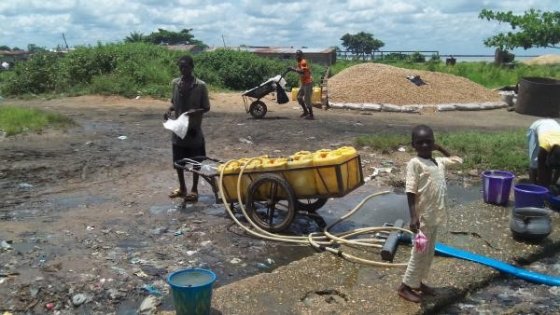
بائع للمياه في ماكورادي بنيجيريا يمأء وعائه بالماء من من نهر بنيو الملوث . المصدر AKVO (n.y.)
مقتبس من KJELLEN & MCGRANAHAN (2006)
عادة بيع المياه هو عمل تنافسي , قد تختلف فيها مستوى وقسوة التنافس فئ أسواق بيع المياه , ولكن الصور النمطية السابقة بأن بائعي المياه مستغليين ويبالغوا في أسعار المياه قد تم تصححيها بالاعتراف أن أسعار المياه غالبا ما تكن متناسبة مع تكاليفها الحقيقية (UN-HABITAT 2003). إن التنافس في ذلك المجال يحدث بسبب أنه يوجد الكثير من الأشخاص بدون وظائف ويعد دخول سوق بيع الماءأمرا سهلا ولكن تحقيق ربح في ذلك المجال يعد أمرا صعبا . حيث يجب على الباعة الحفاظ على استمرارية ولاء زبائنهم لهم والحفاظ على سلامة معداتهم الناقلة للمياه ويجب أن يكون لهم قدرة كبيرة على التكيف والابتكار للبقاء في ذلك السوق التنافسي (COLLIGNON & VEZINA 2000). , ذلك هناك حالات حيث يعتمد الفقراء بشكل أساسي على البائعين لذا حينها تكون تجارة المياه مربحة كما في جاكرتا .(KJELLEN & MCGRANAHAN 2006).انظر ايضا الوصول للمياه والصرف الصحى
على أى حال أن المياه المباعة أكثر من توصيل المياه للمنازل إن وجدت أو الصنابير العامة , ولكن أنظمة بيع المياه تبدو أكثر قوة من أنظمة الأنابيب في البلدان النامية , حيث على سبيل المثال فى بلدان مثل دار السلام وتنزانياحيث كثير من المقيمون لا يعتمدون علي امدادات المياه بالانابيب,ظهر أن المياه من بائعي المياه تكلف أكثر بحوالي 10 -40 مرة عن تكاليف المياه الموصولة بالمنازل على حسب شروط الامداد وموقع المستهلك , ومع ذلك فان المياه المباعة في اكشاك البيع لا تكلف سوى أربع مرات أكثر عن المياه الموصولة بالمنازل ( أنظر الجدول).
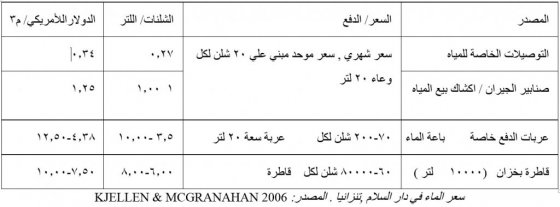
عادة ما يعمل باعة المياه خارج أو على هامش الأطر القانونية والتنظيمية الثابتة KJELLEN & MCGRANAHAN 2006. وغالبا ما يتم تثبيط واعاقة نشاطهم, كمثال بالتجاهل أو القمع. ومع ذلك، فإن معظم المرافق تفضل عدم معاقبة الأسر التي تشتري الماء ، و بائعي المياه هم عرض لمشكلة عدم كقاية امداد وتوفير المياه وليس سببا لها، KJELLEN & MCGRANAHAN 2006).)
من الصعب تنظيم توزيع البائعين: يرجع ذلك جزئيا لعددهم الهائل وكثرة تنقلهم، ويرجع ذلك جزئيا إلى انخفاض مستوى الكسب. ان الضرائب أو التراخيص قد تؤدى إلى ارتفاع أسعار المياه أو استخراج مستحقات بدلا من جلب عائدات الضرائب أو تحسين النظافة الأساسية. إذا كان بيع المياه غير قانوني أو إذا تم وضع معايير عالية جدا، ستكون النتيجة الخالصة في كثير من الأحيان كميات أقل من المياه التي يتم توفيرها في مستوى أقل من ذلك من الذي يصل إلى السوق السوداء انظر أيضا تسعير المياه بشكل عام KJELLEN & MCGRANAHAN 2006.
وفيما يتعلق بمراقبة الجودة، حيثما توجد نظم رسمية، من المرجح أن تكون الأولوية هي زيادة فرص الحصول على إمدادات المياه الرسمية أو تعزيز معالجة المياه المنزلية بدلا من التحكم في نوعية المياه المباعة من بائعي المياه (انظر أيضا نقطة استخدام المياه المعالجة، زيادة الوعي في تنقية الماء الحصول على المياه والصرف الصحي و المياه والاقتصاد) (منظمة الصحة العالمية 2011).
ومن المشاكل الرئيسية بالنسبة للمستهلكين ارتفاع أسعار المياه في كثير من أسواق المياه غير الرسمية. ونادرا ما يكون تنظيم السعر المحمل خيارا لأن التحكم صعب. ومع ذلك، قد يكون من الممكن إزالة القيود التي تدفع أسعار البائعين لأعلى. على سبيل المثال. فإن معاقبة بائعي المياه حيث لا يوجد خيار آخر لإمدادات المياه لا يحافظ إلا على ارتفاع الأسعار. ويعني ذلك استحداث وتبني بيئة تمكينية للأعمال التجارية، على سبيل المثال تغيير القانين الي هي ضد بائعي المياه وتسهيل وصولهم لموارد المالية ( انظر ايضا استحدات بيئة تمكين لمصادر الماء . الشراكات بين القطاعين العام والخاص، المساهمات الحكومية، الإعانات، التمويل الأصغر و تقاسم التكاليف KJELLEN & MCGRANAHAN 2006.
حل قصير الامد في المناطق الحضرية النامية والمناطق شبه الحضرية
الشراكات الممكنة بين مسئولي المرافق وصغار مقدمي الخدمات
Water Vendor in Nigeria
Informal Water Suppliers Meeting Water Needs in the Pero-Urban Territories of Mumbai, an Indian Perspective
This paper addresses the issue of informal water providers in the peri-urban areas of Mumbai. The paper examines whether we are heading towards new forms of urban governance, where informal actors no longer compete with each other, but cooperate with public utilities and emerge as an extension of the public utility.
ANGUELTOU-MARTEAU, A. (2008): Informal Water Suppliers Meeting Water Needs in the Pero-Urban Territories of Mumbai, an Indian Perspective. Grenoble: Université de Grenoble URL [Accessed: 30.11.2012]Independent Water and Sanitation Providers in African Cities. Full Report of a Ten-Country Study
This ten-country study in Africa, provides a wealth of information on a vibrant independent water and sanitation sector that responds to market niches and meets the needs of both the poor and other unserviced communities on a very broad scale. The countries covered were Benin, Burkina Faso, Côte d’Ivoire, Guinea, Kenya, Mali, Mauritania, Uganda, Senegal, and Tanzania. The overall picture that emerges from the study suggests that by recognizing and regularizing the activities, roles, and institutional position of independent providers, and by facilitating intermediation, coordination, and partnership between city-wide operators and independent providers, municipal and national authorities can set the stage for better delivery of water and sanitation services to the urban poor.
COLLIGNON, B. VEZINA, M. (2000): Independent Water and Sanitation Providers in African Cities. Full Report of a Ten-Country Study. Washington, DC: UNDP-World Bankd Water and Sanitation Program URL [Accessed: 30.11.2012]Case Study: Water Kiosks. How the combination of low-cost technology, pro-poor financing and regulation leads to the scaling up of water supply service provision to the poor
Water kiosks are a low-cost technology to scale up the water supply to the poor. The approach taken typically includes the decentralisation and commercialisation of water supply and sanitation (WSS) services, taking into account the needs of the poor in particular. This report gives an introduction to the water kiosk concept, its impact and challenges, and an example of a best practice implementation: the case of Zambia.
GTZ (2009): Case Study: Water Kiosks. How the combination of low-cost technology, pro-poor financing and regulation leads to the scaling up of water supply service provision to the poor. Eschborn: Deutsche Gesellschaft für Technische Zusammenarbeit (GTZ) GmbH. [Accessed: 22.03.2019] PDFProvision of Water to the Poor in Africa. Experience with Water Standposts and the Informal Water Sector
This paper reviews recent literature and available data on standpipes and the informal water sector in Sub-Saharan Africa. It identifies gaps in the research and outlines recommendations for additional research on water provision for the poor.
KEENER, S., LUENGO, M. and BANERJEE, S. (2010): Provision of Water to the Poor in Africa. Experience with Water Standposts and the Informal Water Sector. Washington, DC: The World Bank URL [Accessed: 22.03.2019] PDFInformal Water Vendors And The Urban Poor
This working paper looks at how water-vending systems operate, how effective they are in meeting the needs of the urban poor, and how this effectiveness might be improved. The paper concentrates on the small-scale and informal vendors, most of whom work independently with very little capital. Nevertheless, they display enormous diversity and flexibility, and are adept at responding to the needs of all but the very poorest households.
KJELLEN, M and MCGRANAHAN, G. (2006): Informal Water Vendors And The Urban Poor. (= Human Settlements Discussion Paper Series ). London: International Institute for Environment and Development (IIED) URL [Accessed: 30.11.2012] PDFCustomers and Providers
Diarrhoea and Effects of Different Water Sources, Sanitation and Hygiene Behaviour in East Africa
Water and Sanitation in the World’s Cities. Local Action for Global Goals
Water vendor delivers water at Suakin using a donkey cart
Water Vending Activities in Developing Countries: A Case Study of Ukunda, Kenya
Vended Water. Chapter 6.1
Water Vending in Developing Countries
إستريجيات الإدارة السليمة لمياه الشرب الصالحة للإستخدام الآدامي
Language: Arabic
تقرير المقررة الخاصة المعنية بحق الإنسان في الحصول على مياه الشرب المأمونة وخدمات الصرف الصحي، مجلس حقوق الإنسان
Language: Arabic
Informal Water Vendors And The Urban Poor
This working paper looks at how water-vending systems operate, how effective they are in meeting the needs of the urban poor, and how this effectiveness might be improved. The paper concentrates on the small-scale and informal vendors, most of whom work independently with very little capital. Nevertheless, they display enormous diversity and flexibility, and are adept at responding to the needs of all but the very poorest households.
KJELLEN, M and MCGRANAHAN, G. (2006): Informal Water Vendors And The Urban Poor. (= Human Settlements Discussion Paper Series ). London: International Institute for Environment and Development (IIED) URL [Accessed: 30.11.2012] PDFIndependent Water and Sanitation Providers in African Cities. Full Report of a Ten-Country Study
This ten-country study in Africa, provides a wealth of information on a vibrant independent water and sanitation sector that responds to market niches and meets the needs of both the poor and other unserviced communities on a very broad scale. The countries covered were Benin, Burkina Faso, Côte d’Ivoire, Guinea, Kenya, Mali, Mauritania, Uganda, Senegal, and Tanzania. The overall picture that emerges from the study suggests that by recognizing and regularizing the activities, roles, and institutional position of independent providers, and by facilitating intermediation, coordination, and partnership between city-wide operators and independent providers, municipal and national authorities can set the stage for better delivery of water and sanitation services to the urban poor.
COLLIGNON, B. VEZINA, M. (2000): Independent Water and Sanitation Providers in African Cities. Full Report of a Ten-Country Study. Washington, DC: UNDP-World Bankd Water and Sanitation Program URL [Accessed: 30.11.2012]Case Study: Water Kiosks. How the combination of low-cost technology, pro-poor financing and regulation leads to the scaling up of water supply service provision to the poor
Water kiosks are a low-cost technology to scale up the water supply to the poor. The approach taken typically includes the decentralisation and commercialisation of water supply and sanitation (WSS) services, taking into account the needs of the poor in particular. This report gives an introduction to the water kiosk concept, its impact and challenges, and an example of a best practice implementation: the case of Zambia.
GTZ (2009): Case Study: Water Kiosks. How the combination of low-cost technology, pro-poor financing and regulation leads to the scaling up of water supply service provision to the poor. Eschborn: Deutsche Gesellschaft für Technische Zusammenarbeit (GTZ) GmbH. [Accessed: 22.03.2019] PDFProvision of Water to the Poor in Africa. Experience with Water Standposts and the Informal Water Sector
This paper reviews recent literature and available data on standpipes and the informal water sector in Sub-Saharan Africa. It identifies gaps in the research and outlines recommendations for additional research on water provision for the poor.
KEENER, S., LUENGO, M. and BANERJEE, S. (2010): Provision of Water to the Poor in Africa. Experience with Water Standposts and the Informal Water Sector. Washington, DC: The World Bank URL [Accessed: 22.03.2019] PDFﺇﺩﺍﺭﺓ ﺍﻟﻄﻠﺐ ﻋﻠﻰ المياه ﺑﺎﻟﻮﻃﻦ العربي . ﺣﺎﻟﺔ ﺩﺭﺍﺳﻴﺔ :ﺳﻮﺭﻳﺔ. المؤتمر الدولي الثاني ﻟﻠﻤﻮﺍﺭﺩ المائية ﻭﺍﻟﺒﻴﺌة الجافة.
Language: Arabic
Informal Water Suppliers Meeting Water Needs in the Pero-Urban Territories of Mumbai, an Indian Perspective
This paper addresses the issue of informal water providers in the peri-urban areas of Mumbai. The paper examines whether we are heading towards new forms of urban governance, where informal actors no longer compete with each other, but cooperate with public utilities and emerge as an extension of the public utility.
ANGUELTOU-MARTEAU, A. (2008): Informal Water Suppliers Meeting Water Needs in the Pero-Urban Territories of Mumbai, an Indian Perspective. Grenoble: Université de Grenoble URL [Accessed: 30.11.2012]Water Vending in Nigeria. A Case Study of Festac Town, Lagos, Nigeria
Festac Town, Lagos, Nigeria is a typical community that is presently not being serviced by water utilities. Households therefore seek other alternative sources including water vending. This paper examined the role of water vending in household water supply delivery in this community. It identified the sources of water supply by the vendors, assessed their level of patronage among households and identified the problems associated with their operations. The paper concludes that the most sustainable strategy would be to resuscitate the moribund piped water supply system earlier initiated by the Water Supply Agency (WSA).
OLAJUYJUGBE, A.E. ; ROTOWA, A.E. ; ADEWUMI, I.J. (2012): Water Vending in Nigeria. A Case Study of Festac Town, Lagos, Nigeria. المُدخلات: Mediterranean Journal of Social Sciences: Volume 3 , 1. URL [Accessed: 09.07.2019]Case Study: Water Kiosks. How the combination of low-cost technology, pro-poor financing and regulation leads to the scaling up of water supply service provision to the poor
Water kiosks are a low-cost technology to scale up the water supply to the poor. The approach taken typically includes the decentralisation and commercialisation of water supply and sanitation (WSS) services, taking into account the needs of the poor in particular. This report gives an introduction to the water kiosk concept, its impact and challenges, and an example of a best practice implementation: the case of Zambia.
GTZ (2009): Case Study: Water Kiosks. How the combination of low-cost technology, pro-poor financing and regulation leads to the scaling up of water supply service provision to the poor. Eschborn: Deutsche Gesellschaft für Technische Zusammenarbeit (GTZ) GmbH. [Accessed: 22.03.2019] PDFInformal Water Vendors and Service Providers in Uganda: The Ground Reality
This paper is a beginning or a starting point for further research informal water vending in Uganda and highlights issues for further research, discussion and policy formulation. The paper is based almost entirely on primary information around Kampala and several small towns. More than 20 localities, mostly slums, informal settlements and poorer sections of Kampala were visited in order to find out how and from where people obtained water and the price they paid for it. Discussions were held directly with consumers, vendors, government authorities, and NGOs.
PANGARE, G. PANGARE, V. (2008): Informal Water Vendors and Service Providers in Uganda: The Ground Reality. Bonn: The Water Dialogues. [Accessed: 04.12.2012] PDFEnvironmental Factsheet. Independent Water Entrepreneurs in Latin America
This report outlines the findings of the six-country study (Paraguay, Argentina, Colombia, Guatemala, Peru and Bolivia) of small-scale providers of water supply and sanitation service in Latin America carried out by the Water and Sanitation Program.
SOLO (2003): Environmental Factsheet. Independent Water Entrepreneurs in Latin America. Washington DC: The World Bank URL [Accessed: 17.05.2019]Services and Supply Chains: The Role of the Domestic Private Sector in Water Service Delivery in Tanzania
This report presents findings from a review of the service activities of informal private water vendors in Dar es Salaam. Tanzania’s capital is a rapidly growing city, and around 70 percent of the population lacks proper housing and lives in informal settlements. Large parts of the city remain unserved by the water utility and many of those who have access to the piped network suffer from intermittent supply. As a result, small-scale private water vendors provide an essential service for many, in particular low-income households in the city that would not otherwise be served. Yet, the overall result is an extremely costly service, which heavily penalizes low-income households.
UNDP (2011): Services and Supply Chains: The Role of the Domestic Private Sector in Water Service Delivery in Tanzania. New York: United Nations Development Programme URL [Accessed: 04.12.2012]Small-Scale Water Providers in Kenya: Pioneers or Predators?
In Kenya small-scale private water providers have entered the market to fill the gap left in public service provision. This study examines what role they play in ensuring affordable, safe and reliable water supply. It finds that small-scale providers increase water supply coverage and reduce time poverty. However, low-income households pay high prices for water of questionable quality.
UNDP (2011): Small-Scale Water Providers in Kenya: Pioneers or Predators? . New York: United Nations Development Programme URL [Accessed: 30.11.2012]The Experience of Small-Scale Water Providers in Serving the Poor in Metro Manila
Small-scale water providers continue to supply water to many parts of Metro Manila, the Philippines. The study found that a high proportion of the poor rely on water services supplied by small-scale water providers, but that these households pay a higher unit rate for the water than their more affluent neighbours. The study yields a number of recommendations, including rationalizing the price of water for poor customers, improving service efficiencies to reduce the costs of supplying water, and developing collaborative relationships among the government regulator, utility, and small-scale water providers.
WSP (2004): The Experience of Small-Scale Water Providers in Serving the Poor in Metro Manila. Washington, D.C.: The Water and Sanitation Programme of the World Bank Group URL [Accessed: 09.07.2019]Get to Scale in Urban Sanitation!
Taking urban sanitation to scale requires ‘scaling out’ models that work for poorer communities, and at the same time ‘scaling up’ sustainable management processes. This short note reports scale-out and scale-up experience from Maputo and Antananarivo.
WSUP (2013): Get to Scale in Urban Sanitation!. (= Practice Note , 10 ). London: Water and Sanitation for the Urban Poor (WSUP) URL [Accessed: 22.04.2019]Water Kiosks. Bringing sustainable water supply and sanitation to the urban poor
This flyer shows the benefits of water kiosks at a glance, as well as their design elements, management concept and impact.
GTZ (2009): Water Kiosks. Bringing sustainable water supply and sanitation to the urban poor. Eschborn: Deutsche Gesellschaft für Technische Zusammenarbeit (GTZ) GmbH PDFSmall-Scale Water & Sanitation
Here you find more material about the private sector participation of small-scale water providers, particularly in Africa.
The Lives of Jakarta's Street Vendors - Hasanuddin, Water Seller
The film “The Lives of Jakarta's Street Vendors - Hasanuddin, Water Seller” is a short portrait of the water vendor Hasanuddin. It gives an insight into the water vending system in Jakarta.


